First Look: Panasonic DVX200 handheld 4K pro camcorder
Watch our video above or read on…
If it sounds too good to be true, it probably is. Sage advice that’s often dished out by Trading Standards about dubious quotes for building work but just as applicable to all walks of life. So with a 4K-capable handheld camcorder offering standard and V-Log filming at 50p (60 for those who use that format) onto SDXC media, are Panasonic offering more than they can deliver?

At a press event for bloggers and vloggers in central London, the company showcased their new AG-DVX200 and touted it around for us to play with. Not one, not two but three professional film-makers were wheeled out to tell us about their experience with the camera on a Panasonic-sponsored jaunt to Japan, though each had seemingly very little time to actually acquaint themselves with their kit let alone film much. They were also, Panasonic were at pains to point out, using very much pre-production models.
We were given time to ask questions and then, after a spot of lunch (slightly oddly, chips with assorted finger food), an opportunity to put our own SD cards into the machines and go out onto the Soho streets to press “record” and capture some of our own shots. It was a good chance to feel the ergonomics of the camera too, to heft it just as you would in a real “run and gun” situation.
Let us begin our mulling over the day with a huge caveat though which is that none of us were able to read the user manual before we began, to learn any nuances of the setup. Indeed, we had essentially no time to play with the menus and set the camera up in any sense at all. Thus we filmed almost with whatever settings it had been presented. notwithstanding the odd tweak such as turning on the histogram or playing with peaking and so on.
Initial impressions are that this is one funky-looking unit reminiscent – in a good way – of the lovely old JVC VHS unit that Michael J. Fox touted in “Back to the Future”. If Doc Brown was impressed by that, he’d have been knocked backwards by the capabilities of the DVX200.
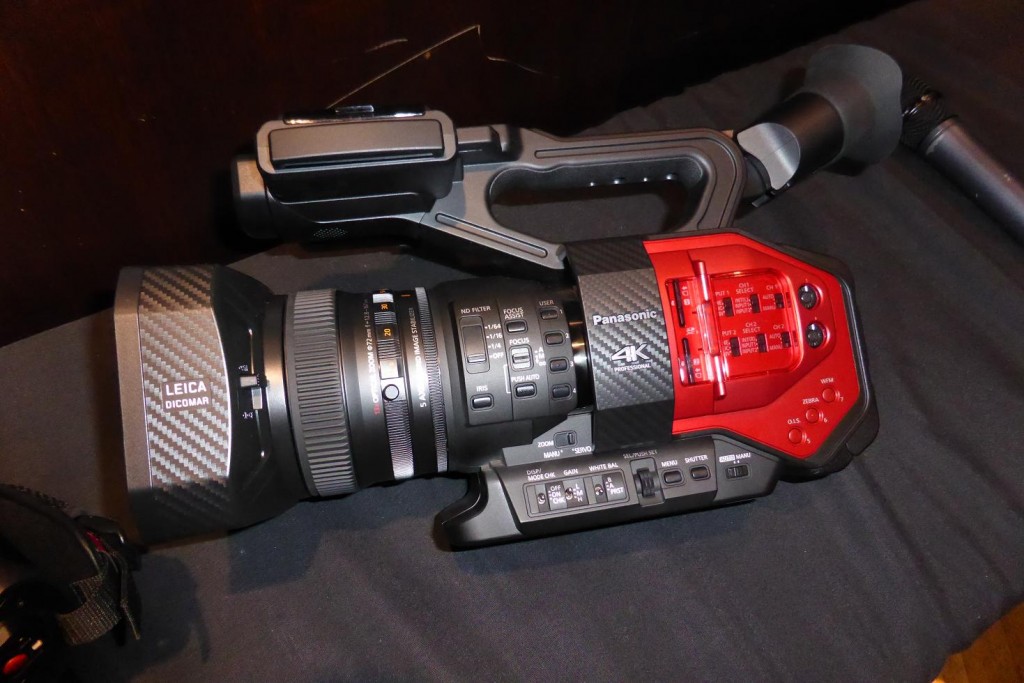
It’s not too heavy and it fits nicely in the hand. Construction is much like the other Panasonic handheld cams which is to say it does look awfully plasticky in a not-reassuring-for-longevity way. Somehow Sony’s equivalent cams look much more metallic and solid despite also being largely plastic. That said, Panny’s UK rep at the event was confident that it will hold up to all manner of outdoor abuse and who are we to disagree?
On top there’s the usual handy record button and a zoom toggle. Disappointingly – and similarly to every other camcorder vendor – there’s no assignable button up there. Doing lots of news shooting, we often find ourselves holding these cams so as to operate them from the top and it would be really handy to have one or two easy-press assignable buttons next to the record button on the top. Sigh. On the upside, there’s a little plastic flap you can pull down over the rec button to stop yourself accidentally pressing it.
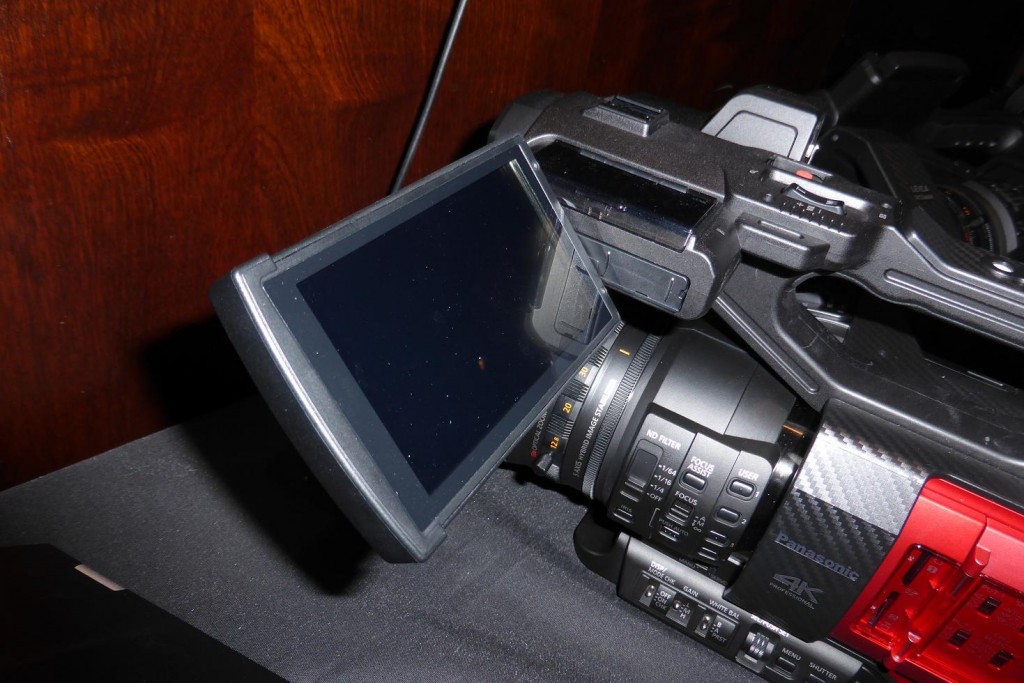 In now-traditional Panasonic style, the flip-out LCD is actually a pull-out jobbie, hiding inside the top handle when not in use. It’s huge, 4.3 inches to be precise, and has just under three million pixels so whilst it’s not 4K in itself, it’s detailed enough that you can get focus especially when allied with the focus assist feature which magnifies part of the image into the centre of the screen and offers coloured peaking to point out sharp edges. We found that we could usually get focus without the assist and that using the magnification simply proved that we were right all along. So it was a comfort but actually not necessary and that must be a compliment for the screen.
In now-traditional Panasonic style, the flip-out LCD is actually a pull-out jobbie, hiding inside the top handle when not in use. It’s huge, 4.3 inches to be precise, and has just under three million pixels so whilst it’s not 4K in itself, it’s detailed enough that you can get focus especially when allied with the focus assist feature which magnifies part of the image into the centre of the screen and offers coloured peaking to point out sharp edges. We found that we could usually get focus without the assist and that using the magnification simply proved that we were right all along. So it was a comfort but actually not necessary and that must be a compliment for the screen.
The lens is fixed and offers a 13x zoom with a wide angle of 28mm at best (this changes according to your shooting format). Delightfully for us news guys, the zoom can be toggled to manual so you can crash in to set focus and pull out again in a flash instead of having to wait for a tedious servo.
But speaking of focus assist, it appears it had to be invoked manually with a button press (and one more to turn it off) instead of operating automatically when we twiddled the focus ring, this will make run and gun shooting for live events really rather problematic because you don’t want to keep taking your hand off the lens to stab at tiny buttons.
Hopefully once we read the manual we’ll discover an option to invoke focus assist as soon as you twist the ring so that you don’t have to keep taking your hands off it to bring up focus assist. Or maybe we could assign focus assist to the button next to the handgrip zoom rocker so your right hand can invoke it.
Speaking of that focus ring, both it and the iris ring are silky smooth in operation, spinning like a hot knife in butter. Poor analogy but you know what we mean. The film-makers who’d tested the pre-production models and given feedback to Panasonic had asked for the amount of turn needed to change focus to be increased so that it’s easier to make fine adjustments. This is sensible to a point – missing focus because the control’s too blunt would be annoying – but also annoying is when you shift from something near to something far and have to madly fling the focus ring round to move the focal point. Perhaps it should be speed sensitive. Or maybe we’ll have to use – whisper it – auto focus if you need a quick change from one extreme to the other.
Also irritating was a noticeable lag on the iris control. You’d turn it and it would follow your instruction but with a clear delay. At times this lead to overshooting the mark and having to nudge it back so accurate quick iris changes were difficult. In a news or live event context this is not helpful. Hopefully Panasonic will cure this with a firmware tweak.
Helpfully there are buttons aplenty on the side of this machine although very frustratingly they didn’t have a solid click or feel when you pressed them, so unless something shows up on screen you won’t know if you really have pressed the button just by feel.
There’s the usual auto/manual focus toggle, ditto for iris. ND filters – 3 plus the neutral. A nicely placed white balance button at the front of the camcorder just under the lens. Incidentally, it took its white balance reading and adjusted faster than any other camcorder we’ve ever used though this may have been a fluke as we only did it once. Nice though.
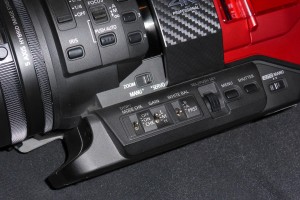
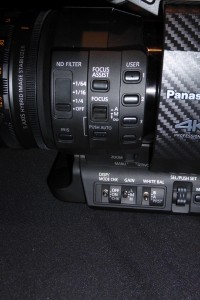 Then you’ve got tiny metal toggles for gain, white balance presets and display info on/off.
Then you’ve got tiny metal toggles for gain, white balance presets and display info on/off.
Audio controls for the two channels are hidden under a plastic flap at the back which flips open and can therefore, like quite a lot of the other flaps on this cam, potentially be ripped off by a careless movement. Opening up the cover for the SD card slots caused a moment’s perplexion (?!) until we worked out that it slides instead of flips, backwards underneath a piece of the camcorder body.
A vast cavern takes up the back of the unit, covered with a bottom-hinged flap. Inside there lies the battery compartment. This section provides a decent platform on which to dig the camera into your shoulder for handheld shots so whilst it’s far from being shoulder-mount, it does mean you can jab it into yourself and (using the screen not the viewfinder) hold it pretty steady, especially when the decent image stabilisation is turned on, of which more later.
Above the battery section there’s a viewfinder with gazillions of pixels and a nice big eyecup that even folk who wear glasses will be able to snuggle into without any light from the sides becoming annoying.
Sadly one thing that is really annoying is the sensor to detect when your eye is up to the viewfinder. You see, this cam can only manage to run either the LCD or the viewfinder but not both. You can manually set which one you want – though this is tiresome since it involves the menus – or it determines which one you’re using by means of this sensor. The trouble is that if you hold anything even near the sensor, it switches off the LCD and turns on the viewfinder. For quite a while we thought the camcorder had a faulty screen until it was realised that just holding it near your body triggers the sensor. We’re not alone in this hatred for the system and informed Panasonic in no uncertain terms so let’s hope there’s an option to toggle the screens via an assignable button in the production firmware.
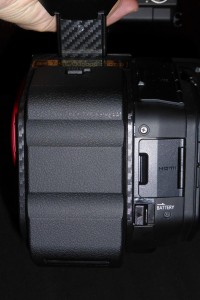
The handgrip is large and comfortable but doesn’t rotate at all. Few do (Sony’s now defunct EX1R and Canon’s XF200 the only examples we can quickly think of) but it’s so useful for good ergonomics that it’s a great shame when it’s not available. Still, most people seem to get along without that feature so perhaps it’s just us being odd. We found the “record” button on the grip wasn’t nearly big enough and was awkwardly positioned for the thumb.
Finally, at the front there’s a flip-open lens hood. Hooray. We’re big fans of these and hate removable lens caps (JVC are you listening?)
So much for the physical device, what about actually using it then?
First of all it needs setting up. This, as already mentioned, is not something we had time or the explanations to do in this limited (45 minute) hands-on session. Clearly though there are plenty of options in the menus which can either be invoked via the touch-screen (for which the on screen menus are easily big enough to be prodded with a fat finger) or, if you prefer not to put sticky marks on your LCD, via a combination of scroll wheel and ‘enter’ button on the side of the camera. Oddly, whereas Sony’s pro cams use a very different system to their consumer models, this Panasonic would feel very much at home to anyone coming up from the home camcorder market. The look and feel, especially on media playback, was very familiar in that context.
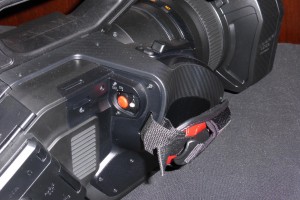
So a lot of scrolling and pushing gets you assorted on-screen display options, movie format options, system setup configuration and so on. It’s easy enough but as with all camcorders, really needs a good hour to sit down and go through to work out how you like it to operate.
Like all screens, the pull-out LCD jobbie is tricky to see outside in daylight. We cranked up the brightness and it was OK but could probably do with a hood of some sort. Oddly, we had trouble getting a feel for exposure, despite switching on a histogram (which, nicely, can be positioned in various places on the screen according to your preference).
Weirdly – we’ve no idea why – turning on the waveform monitor caused all the other display info to vanish completely. A setting in the menus or a design “feature”? No idea but it’s not helpful.
Zebra bars initially refused to show up despite turning the menu option on – then we were told you have to assign zebra to a physical button and turn it on and off there. We did and the wretched things only stayed on screen for about five seconds each time before disappearing again. We do hope this is merely a configuration issue that we didn’t have time to sort and not that the zebras really do only stay briefly on screen each time you invoke them. There was barely enough time to move your hand back to the (laggy!) iris before they’d vanished.
Unusually for a pro cam this one has a proper stabilisation system, seemingly borrowed from Panny’s consumer models (and this is a good thing because it’s very decent on those). It’s a combination of optical and electronic systems which compensates for five axes of movement. Handheld – braced admittedly – on a full 13x zoom the shot was pretty steady except when any abnormal wobble caused the system to re-adjust what it thought you were filming and the image would judder a little. Running along the pavement in that awkward trying-to-move-smoothly-with-slightly-bend-legs gait and the camcorder held from above by the handle gave a reasonably fluid motion (though nothing beats Sony’s “BOSS” system that you find on their consumer handycams).
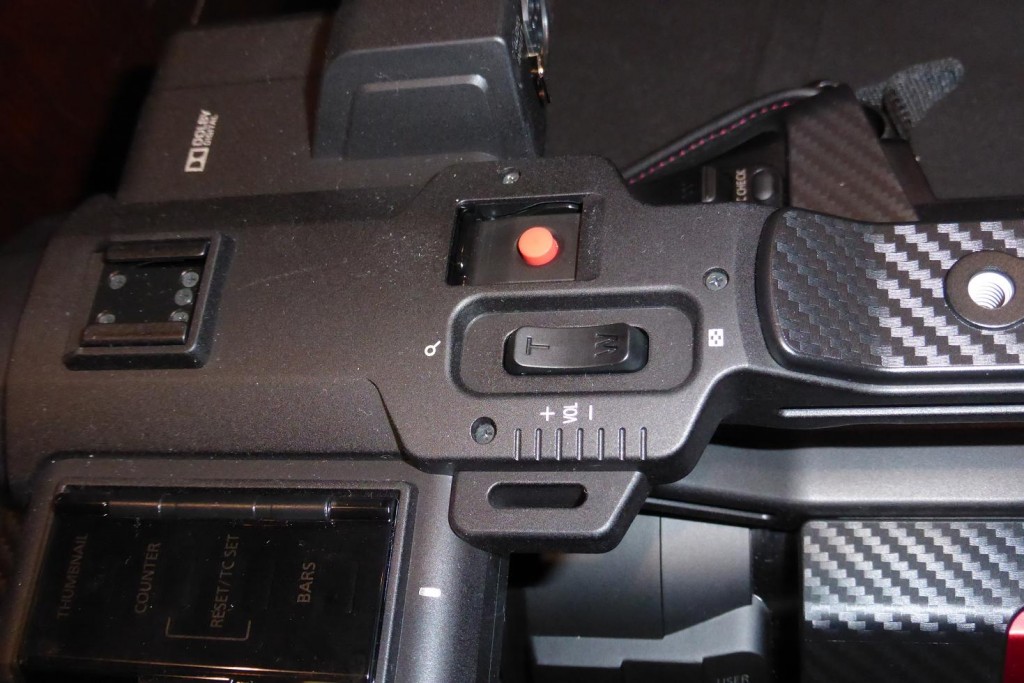
The question that we always get asked about camcorders is “what’s the low light footage like”? Alas, we weren’t able really to test this to any degree. We were shooting mostly outside in bright daylight.
After the demo films shown to us by Panasonic, some in the room said they’d seen noise in the shadows but it’s partly horses for courses – we at Tubeshooter are used to small chip handhelds mostly, notwithstanding extensive use of Sony’s PMW200, and to us the footage looked OK from where we were sitting – and partly viewing conditions that were far from ideal (being two consumer grade 4K TVs playing back off a Macbook with the audience at varying angles to the screen). Let’s not forget that test footage was shot in June on a very much pre-prod model of the camcorder too.
***UPDATE: Having said all the above, and having now watched our own test shots back repeatedly in the comfort of our edit suite, we can confirm that there really is quite a lot of noise in the shadows. Clearly it was us who was in the wrong viewing position for the demo! All the dark parts of the image were jiggling around quite unpleasantly. Shame. ****
Certainly the demo footage looked sharp (oversharpened according to one viewer) and on one of the reels there was hopeless loss of detail in the highlights – but then that particular film had been shot using V-Log L and subsequently given quite a hard grade which was clearly obvious compared to the little-graded Rec 709 footage of the prior sample. With a claimed 12 stops of dynamic range, we don’t think there should be anything to complain about especially – and this is crucial – when you remember the price point this is being pitched at: £3,500 (4,600 euro)! Anyone looking for Varicam standard is barking well up the wrong tree here.
For the price, the features are phenomenal and the picture quality so far as we could tell in this briefest of looks was excellent (in good light). We don’t mean “for the price” detrimentally either, it’s just something you must bear in mind when starting to peep at the pixels with a cinematic eye.
Who’s it for though? It’s a low cost handheld 4K cam with a fixed lens. So, sounds like future news-gathering or corporate event unit perhaps? Well maybe. But it can do true 4K (4096 wide!) at 24p with V-Log profile and that smells of documentaries or low budget film making perhaps. Pressed on who this is for, Panasonic gave us a nice but bland PR answer which didn’t really nail down the markets except to say they claimed a huge number of pre-orders, and that one major broadcaster was intending to use the DVX200 as a complement to their Varicams for a documentary series.
Ultimately perhaps, that’s the answer as Panasonic did acknowledge on one of their early slides to us. This is a run and gun, pick-up-and-shoot camcorder that’s there to complement other more dedicated tools. If you’ve a GH4, use that with all its interchangeable lens functionality when you’ve got the time to set up and compose a shot that’s not going to move much. If you’re using Varicams for your high end work, then the DVX is a quick-and-dirty (sorry Panasonic!) tool to get additional shots. All should match up in the edit due to the common V-Log profile.
For anyone else, this camcorder offers flexibility; by shooting “4K” (OK, UHD at 3840×2160) at a full 50p you’ve got the scope to acquire material at the best possible resolution for archive and future use not to mention cropping into it for a pseudo multi-angle HD shot out of a single camera.
We’re going to reserve judgement until we get that review unit. In the meantime, kudos to Panasonic for bringing it out. There are clearly some things about the DVX200 that annoy us (Iris delay! Auto VF toggle!) but it does show a lot of promise. For the price.
(Incidentally we did stick a card in the machine and take some very quick shots so we’ll post these here soon. Stand by)
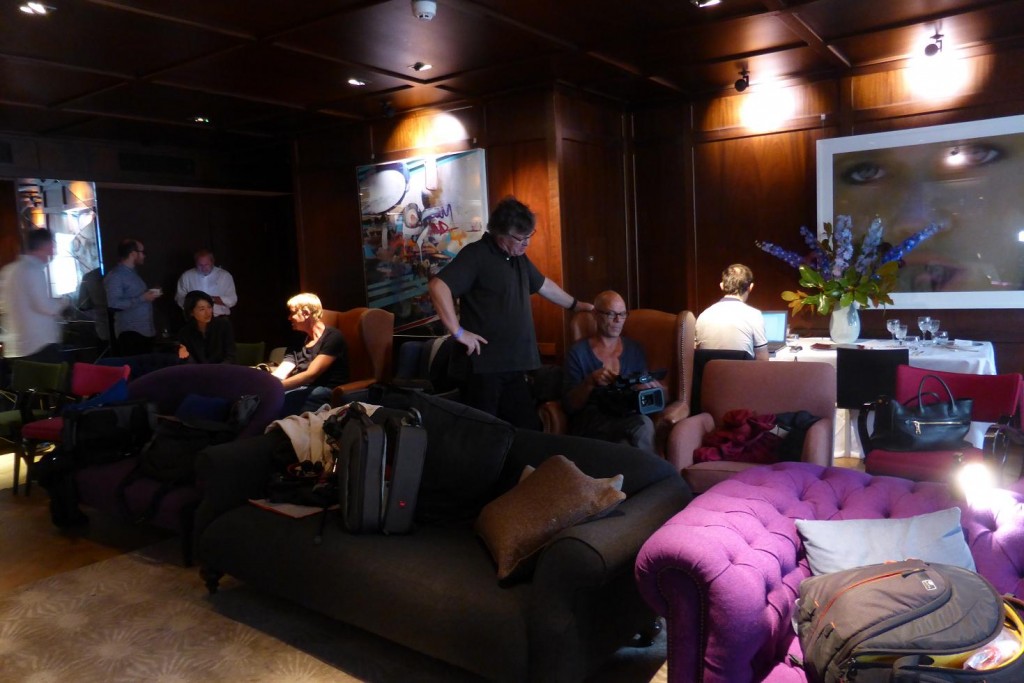
I have this camera. I know what the noise is, its because you used a camera with the 1,1 firmware (which unforgivably is what it comes with)… which is horrible. The 1.5 firmware eliminates the grain at low DB, adds better colour and even adds the WiFi feature of the camera! Its low light capability is now really strong with new update! I am using 6db or 9db with the X1000 while the DVX200 is still using no db!
All in All, a beautiful camera giving beautiful 4K images straight onto a SD card! I use Transcend 128GB cards and you get 1 hour 55 Minutes in UHD at 50P! With the new firmware it’s now the best camera i have ever owned!
That’s good to know. Yes, the camera we looked at was a very early version as various websites were given a press preview day with a short “hands on” so no doubt this was early firmware.